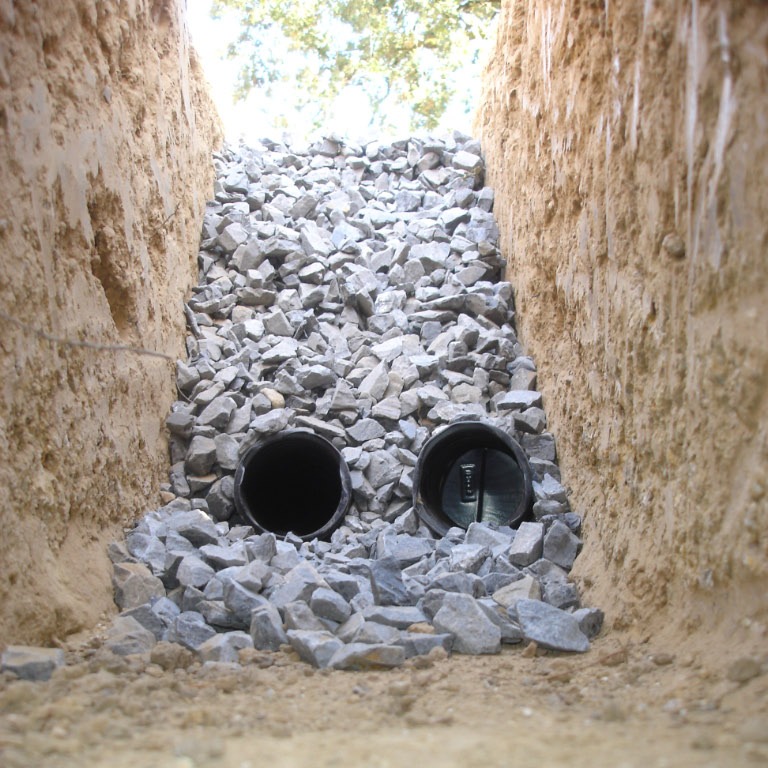
Damp basements breed mold and mildew, which are bad for your health. There are steps you can take to waterproof your basement without making major renovations. Dehumidifiers, waterproof paint, and landscaping best practices can help keep water and moisture out of your basement. But if you’ve tried everything to waterproof your basement, and nothing is quite getting the job done, you might need to install a drainage system. Each system works differently to collect excess groundwater and force it away from your house. Here are the most common basement drainage options.
1. Exterior French Drain
A french drain is essentially a gutter for groundwater. It’s a trench filled with rocks that carries water away from your house. This trench sits around the problem areas of your foundation to grab the water and direct it elsewhere before it can even touch your house.
Your trench should be wider than 12 inches and will need to be deeper than the floor of the basement to be effective.
The trench is partially filled with a layer of gravel, and a perforated PVC pipe is laid around the perimeter of your foundation. Many installers will add some sort of membrane or waterproofing to the outside of your foundation during the process.
The holes should face down so the groundwater can rise into the pipe. Steve Schulz at Dry Basement Solutions says, “If the builder made the additional mistake of installing the drainpipe with the weep holes facing up, then the level of water has to rise to the top of the pipe before the pipe can pick up any water.”
The perforated PVC will be protected from clogging with landscaping fabric. The trench will then be filled with gravel. A thin layer of topsoil can be added at the top, or you can leave the gravel exposed.
Adding an exterior French drain as a retrofit is an expensive and intensive project. To dig a trench around your entire home, installers will have to remove landscaping and exterior hardscape elements, such as concrete walkways. For this reason, many owners of existing homes opt for another method.
2. Interior French Drain and Sump Pump
A cheaper (although still expensive) option for drying out your basement is to install a French drain along the inside perimeter of your walls that channels water into a sump with a pump.
Unlike exterior French drain systems, an interior perimeter drain does not require you to disturb your landscaping and take a jackhammer to your front walk. It will, however, require your installer to jackhammer your basement floor to create a trench around the exterior walls and sump.
There are a number of systems available, from traditional French drains that use perforated pipe to collect and channel the water, to proprietary systems that cost more but can be installed more quickly. The basic idea is to move water that collects along the walls to a low spot (the sump), where it can be pumped outside.
Sump pumps come in several different styles, including submersible, pedestal, battery-operated backup, and water-powered backup. Submersible and pedestal pumps are the most common.
Whichever option you choose, it will be installed in the sump below your basement floor. Submersible pumps are completely submerged in the basin, while pedestal pumps sit partially above the water line.
See also: Wet Basements 101: How To Dry Out That Leaky Basement for Good
3. Floor Drain
This option is only a partial solution and is typically only recommended when building a new home. The floor of the basement is designed to slope toward a drain that leads outside or to the municipal sewage system.
Floor drains can be useful for preventing basement flooding, but they don't prevent moisture from entering the space in the first place. They only collect and remove water that has already made its way in.
Are you planning a basement remodel?
If you are planning to finish or remodel your basement, you'll want to incorporate waterproofing as part of the plan. A good place to start is with a licensed contractor or designer. Our team here at CRD has decades of experience converting basements in older Seattle homes to bright, inviting, dry spaces. We’ve created luxurious master suites, family rooms for the kids, bedrooms for guests, and put bathrooms in places others thought not possible. We can dig down to add headroom or create a custom lighting plan for warmth and welcome. If you are interested in discussing your basement renovation, please don't hesitate to get in touch.
Guide to Hiring a Remodeler
This comprehensive guide walks you through all the steps of choosing who will design and build your project, vetting remodeling companies, and ensuring that you have the best experience.



